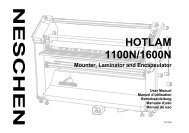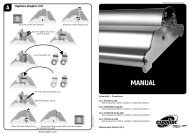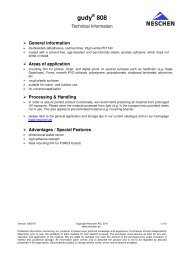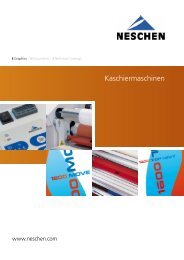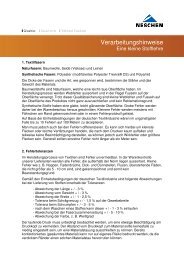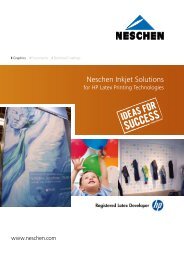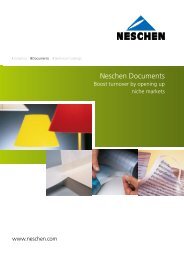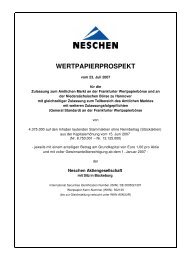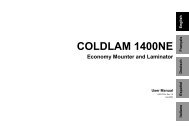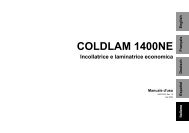Annual Report 2005
Annual Report 2005
Annual Report 2005
You also want an ePaper? Increase the reach of your titles
YUMPU automatically turns print PDFs into web optimized ePapers that Google loves.
54<br />
Notes relating to the consolidated annual accounts<br />
D. Information on currency conversion<br />
I. Basic information<br />
The annual accounts including the hidden reserves covered within the acquisition method and the costs of the consolidated companies as well as the assets<br />
arising from the consolidation of capital have been converted into Euros in accordance with IAS 21 “Effects of changes to exchange rates” based on the concept<br />
of functional currency. Functional currency is the main currency in which a foreign company has its assets and which it uses to make payments. Since the<br />
functional currency for all the Group companies is the national currency in each case, the assets and liabilities have been converted using the average rates on<br />
the closing date while expenditure and income have been converted using the annual average rates. The difference compared with the closing date exchange<br />
rates is shown separately in the shareholders’ equity capital in the column “Changes to shareholders’ equity capital not affecting the result” and does not<br />
affect the annual result. Foreign currency receivables and liabilities have been valued at the closing date exchange rate and the resulting exchange rate differences<br />
are taken into account in the result for the period. By way of exception, exchange rate differences from long-term monetary items within the Group are<br />
entered under shareholders’ equity capital without affecting the result.<br />
Conversion of the main currencies used within the Group was carried out based on the following exchange rates:<br />
The exchange rates varied as shown below:<br />
Closing date exchange rates Average exchange rates<br />
<strong>2005</strong> 2004 <strong>2005</strong> 2004<br />
EUR EUR EUR EUR<br />
1 US dollar (USD) 0.845023 0.73314 0.803148 0.803994<br />
1 pound sterling (GBP) 1.455604 1.41255 1.462309 1.473405<br />
1 Hungarian forint (HUF) 0.003958 0.00408 0.004027 0.003995<br />
1 Hong Kong dollar (HKD) 0.108959 0.09430 0.104060 0.103032<br />
1 Czech koruna (CZK) 0.034495 0.03286 0.033607 0.031368<br />
II. Information on high inflation<br />
The annual accounts of subsidiary companies in countries where there is high inflation are converted in accordance with IAS 29 “Accounting in countries with<br />
high inflation”. Assets and liabilities as well as items from the profit and loss account are converted at the closing date exchange rate. This does not currently<br />
affect any Group companies.<br />
E. Information on the balance sheet<br />
I. Main accounting and valuation methods<br />
Assets available for sale<br />
Long-term assets available for sale have been entered at the lower of book value and current value minus any outstanding sales costs.<br />
Long-term assets and impersonal entities are classified as being “available for sale” if their book value would be obtained if they were sold rather than if they<br />
were to continue to be used. This condition is not considered to have been met until sale is highly likely and the asset is ready to be sold immediately. The management<br />
must have decided on the sale and plans must be in place for the sale to take place within the next year after the asset has been qualified as being “available<br />
for sale”.<br />
Intangible assets<br />
Goodwill and company values from the consolidation of capital will be shown as assets in accordance with IFRS 3 “Corporate mergers” and audited once a year<br />
on a regular basis - and also at more frequent intervals if evidence shows that it is necessary - to check for depreciation. If necessary, depreciation will be applied<br />
and their value will be reduced to a lower recoverable amount. If the reasons for unscheduled depreciation in previous years should cease to apply, the value<br />
will not be adjusted upwards.<br />
As a result of the application of IFRS 3, instead of scheduled depreciation a check on depreciation will be carried out (impairment check). This will involve comparing<br />
the book value with the recoverable amount. The recoverable amount is determined in the form of the useful life as the current value of expected future<br />
cash flows. Expected future cash flows are based on a qualified planning process which takes account of empirical values within the company as well as supporting<br />
economic data from outside the company.<br />
The interest rate for capitalisation was derived as the average weighted capital rate using the capital asset pricing model from data relating to the capital market.<br />
The substantiation of company values was carried out at the level of the so-called “cash-generating unit” (CGU). The CGU is defined as the smallest identifiable<br />
group of assets which generate fund flows which are, to the greatest possible extent, independent from fund flows relating to other assets or other groups of<br />
assets.<br />
Other intangible assets acquired against payment are shown based on their acquisition costs. Intangible assets created by the company are shown as assets based<br />
on their manufacturing costs if the criterion for showing items as assets has been met in accordance with IAS 38 “Intangible assets”. Manufacturing costs inclu-




